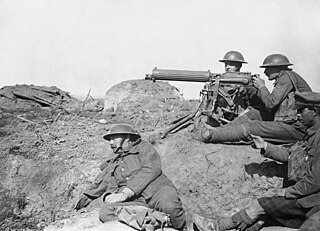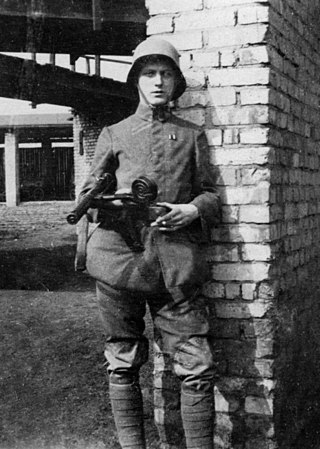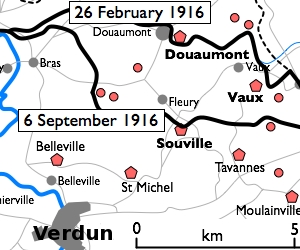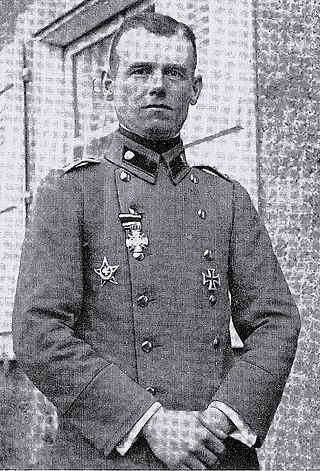
The Battle of Verdun was fought from 21 February to 18 December 1916 on the Western Front in France. The battle was the longest of the First World War and took place on the hills north of Verdun-sur-Meuse. The German 5th Army attacked the defences of the Fortified Region of Verdun and those of the French Second Army on the right (east) bank of the Meuse. Using the experience of the Second Battle of Champagne in 1915, the Germans planned to capture the Meuse Heights, an excellent defensive position, with good observation for artillery-fire on Verdun. The Germans hoped that the French would commit their strategic reserve to recapture the position and suffer catastrophic losses at little cost to the German infantry.

A flamethrower is a ranged incendiary device designed to project a controllable jet of fire. First deployed by the Byzantine Empire in the 7th century AD, flamethrowers saw use in modern times during World War I, and more widely in World War II as a tactical weapon against fortifications.

Trench warfare is a type of land warfare using occupied lines largely comprising military trenches, in which combatants are well-protected from the enemy's small arms fire and are substantially sheltered from artillery. It became archetypically associated with World War I (1914–1918), when the Race to the Sea rapidly expanded trench use on the Western Front starting in September 1914.

Technology during World War I (1914–1918) reflected a trend toward industrialism and the application of mass-production methods to weapons and to the technology of warfare in general. This trend began at least fifty years prior to World War I during the American Civil War of 1861–1865, and continued through many smaller conflicts in which soldiers and strategists tested new weapons.

Stormtroopers were specialist infantry soldiers of the German Army. In the last years of World War I, Stoßtruppen were trained to use infiltration tactics – part of the Germans' improved method of attack on enemy trenches. The German Empire entered the war certain that the conflict would be won in the course of great military campaigns, thus relegating results obtained during individual clashes to the background; consequently the best officers, concentrated in the German General Staff, placed their attention on maneuver warfare and the rational exploitation of railways, rather than concentrating on the conduct of battles: this attitude gave a direct contribution to operational victories of Germany in Russia, Romania, Serbia and Italy, but it resulted in failure in the West. Thus the German officers on the Western Front found themselves in need of resolving the static situation caused by trench warfare on the battlefield.

A flame tank is a type of tank equipped with a flamethrower, most commonly used to supplement combined arms attacks against fortifications, confined spaces, or other obstacles. The type only reached significant use in the Second World War, during which the United States, Nazi Germany, Soviet Union, Italy, Japan, and the United Kingdom all produced flamethrower-equipped tanks.

The M2 flamethrower was an American, man-portable, backpack flamethrower that was used in World War II, the Korean War, and the Vietnam War. The M2 was the successor to the M1 and M1A1 flamethrowers. Although its burn time was around 7 seconds long, and the flames were effective around 20–40 meters, it was still a useful weapon. With the arrival of flamethrower tanks, the need for flamethrower-carrying infantrymen to expose themselves to enemy fire had been greatly reduced.
Richard Fiedler was a German scientist who invented the modern flamethrower. This is a weapon that projects a stream of nitrogen. He submitted evaluation models of his Flammenwerfer to the German Army in 1901. The most significant model submitted was a man-portable device, consisting of a vertical single cylinder 4 feet long, horizontally divided in two, with pressurized gas in the lower section and flammable oil in the upper section. On depressing a lever the propellant gas forced the flammable oil into and through a rubber tube and over a simple igniting wick device in a steel nozzle. The weapon projected a jet of fire and enormous clouds of smoke some 20 yards. It was a single-shot weapon - for burst firing, a new igniter section was attached each time it was used for battle or other uses of any sorts. It was first used on the western front both by the Central Powers and the Entente.

Fort Douaumont was the largest and highest fort on the ring of 19 large defensive works which had protected the city of Verdun, France, since the 1890s. By 1915, the French General Staff had concluded that even the best-protected forts of Verdun could not withstand bombardments from the German 420 mm Gamma guns. These new super-heavy howitzers had easily taken several large Belgian forts out of action in August 1914. Fort Douaumont and other Verdun forts were judged ineffective and had been partly disarmed and left virtually undefended since 1915. On 25 February 1916, Fort Douaumont was entered and occupied without a fight by a small German raiding party comprising only 19 officers and 79 men, entering via an open window by the moat. The easy fall of Fort Douaumont, only three days after the beginning of the Battle of Verdun, shocked the French Army. It set the stage for the rest of a battle which lasted nine months, at enormous human cost. Douaumont was finally recaptured by three infantry divisions of the Second Army, during the First Offensive Battle of Verdun on 24 October 1916. This event brought closure to the battle in 1916.

The Flamethrower, Portable, No 2, also known as the Ack Pack, was a British design of flamethrower for infantry use in the Second World War.

The Flammenwerfer 35, or FmW 35 was a one-man German flamethrower used during World War II to clear out trenches and buildings. It could project fuel up to 25 meters from the user.

The Einstossflammenwerfer 46 was a handheld single shot flamethrower designed in Germany during the second half of World War II and introduced in 1944; it was engineered to be both cheap and easily mass-produced, falling into the category of throwaway flamethrower. The disposable weapon fired a half-second burst of flame of up to 27 metres (89 ft). It was issued to the Volkssturm or the Werwolf movement, but also used by the Fallschirmjäger . It was inspired by the Italian "Lanciafiamme Mod. 41 d'assalto".

The first German man-portable flamethrower was called the Kleinflammenwerfer or Kleif. Fuel was stored in a large vertical, cylindrical backpack container. High-pressure propellant was stored in another, smaller container attached to the fuel tank. A long hose connected the fuel tank to a lance tube with an igniting device at the nozzle. The propellant forced the fuel through the hose and out of the nozzle at high speed when a valve was opened. The igniting device at the nozzle set fire to the fuel as it sprayed out. The flamethrower was operated by two soldiers, one carrying the fuel and propellant tanks, another wielding the lance. Wex, a replacement for the Kleif, was introduced in 1917 after the third battle of Ypres.

The Wechselapparat (Wex) was a World War I German flamethrower introduced in 1916 to replace the earlier Kleif. Developed by Richard Fiedler, as early as 1901. It had a doughnut-shaped backpack fuel container with a spherical propellant container (nitrogen) in the middle that blasted the gasoline. The containers were made of welded car rims, which made it easier to carry it yourself. A corrugated rubber hose led from the tank at the ends of which there were valves that enables mixture of fuel and propellant dispensing under pressure to the metal fuel pipe which had handles on both sides. Wex used a magnesium ignition system in a nozzle. In order for the fire to burn longer, tar was added to the gasoline or instead of it fuel oil was completely used up. It was used throughout the war, and some survived flamethrowers have been used by the Finns in the 1920s and then converted to Flammenwerfer 40. This design was updated before the Second World War to become the Flammerwerfer 35. However, it was considered too fragile so it was soon replaced by the Flammenwerfer 41, a simpler construction with smaller, horizontal, cylindrical backpack containers.
The Grossflammenwerfer or Grof is a large flamethrower, designed to be used from the trenches. In addition to man-portable units, the Germans designed heavy flamethrowers before and during the First World War. The fuel and propellant containers were too large and heavy for mobility, but the hose could be long enough to be carried out of the trenches closer to the enemy. Multiple propellant and fuel containers could be connected together to improve range and usage time.

The M1 and M1A1 were portable flamethrowers developed by the United States during World War II. The M1 weighed 72 lb, had a range of 15 meters, and had a fuel tank capacity of five gallons. The improved M1A1 weighed less, at 65 lb, had a much longer range of 45 meters, had the same fuel tank capacity, and fired thickened fuel (napalm).
Livens Large Gallery Flame Projectors were large experimental flamethrowers used by the British Army in World War I, named after their inventor, Royal Engineers officer William Howard Livens.

Willy Martin Ernst Rohr was a German Army officer who was a major contributor to the development of infantry tactics in World War I, particularly for the system of Storm Battalions.

Assault Battalion No. 5 (Rohr), was an experimental infantry battalion of the Imperial German Army during World War I. Under command of its namesake, Hauptmann Willy Rohr, it became known for its innovations in infantry tactics that would give rise to the German Stoßtruppen. The battalion began as a combat engineer detachment of the 8th Army Corps, part of a larger effort among German commanders to try and gain the tactical upper hand following the strategic and operational stagnation of trench warfare on the Western Front of World War I. The unit pioneered what would later be referred to as Stoßtrupptaktik, a body of field tactics taught to every subsequent German assault unit.
The Lanciafiamme Mod. 41 d'assalto was an flamethrower used by the Royal Italian Army during World War II, The mod. 41 was meant to be an extremely light and compact flamethrower to equip paratroopers and Assault Engineers, The flamethrower remained in use after the war until 1998.
















